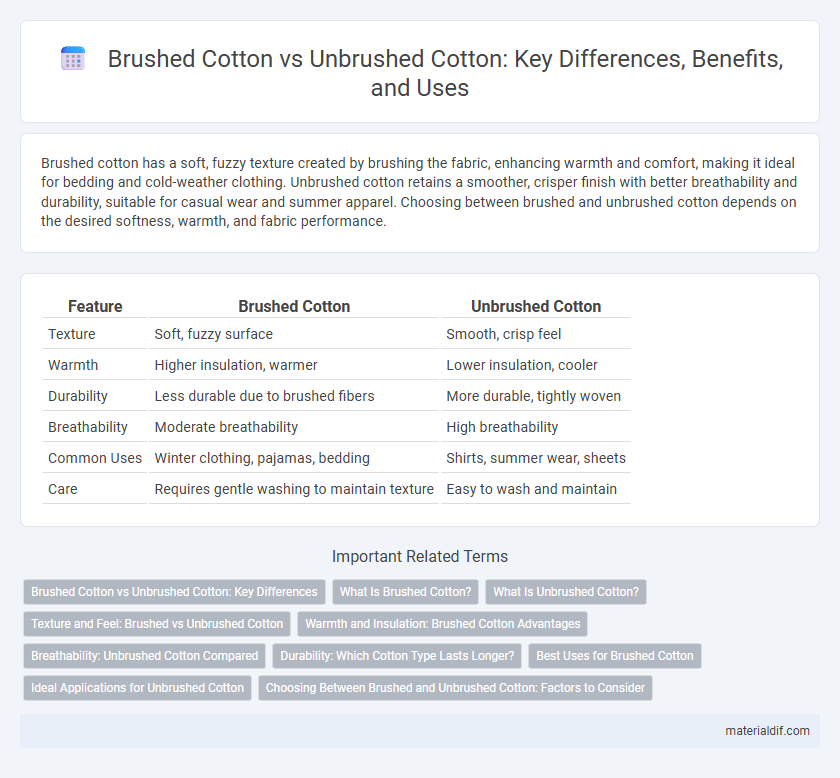Brushed cotton has a soft, fuzzy texture created by brushing the fabric, enhancing warmth and comfort, making it ideal for bedding and cold-weather clothing. Unbrushed cotton retains a smoother, crisper finish with better breathability and durability, suitable for casual wear and summer apparel. Choosing between brushed and unbrushed cotton depends on the desired softness, warmth, and fabric performance.
Table of Comparison
| Feature | Brushed Cotton | Unbrushed Cotton |
|---|---|---|
| Texture | Soft, fuzzy surface | Smooth, crisp feel |
| Warmth | Higher insulation, warmer | Lower insulation, cooler |
| Durability | Less durable due to brushed fibers | More durable, tightly woven |
| Breathability | Moderate breathability | High breathability |
| Common Uses | Winter clothing, pajamas, bedding | Shirts, summer wear, sheets |
| Care | Requires gentle washing to maintain texture | Easy to wash and maintain |
Brushed Cotton vs Unbrushed Cotton: Key Differences
Brushed cotton features a soft, fuzzy texture achieved by gently sanding the fabric's surface, enhancing warmth and comfort compared to unbrushed cotton's smoother, crisper feel. This finishing process increases softness, making brushed cotton ideal for cozy apparel and bedding, whereas unbrushed cotton is more breathable and durable, suited for shirts and casual wear. The key differences lie in texture, warmth, and intended use, with brushed cotton offering a plush, insulating quality and unbrushed cotton maintaining a lightweight, versatile character.
What Is Brushed Cotton?
Brushed cotton is a type of fabric that undergoes a mechanical process where fine brushes lift fibers from the cotton surface, creating a soft, fuzzy texture that enhances warmth and comfort. This treatment increases the fabric's insulation properties and gives it a velvety feel, making it popular for bedding and cozy clothing. Unlike unbrushed cotton, which has a smooth and crisp finish, brushed cotton offers a plush surface ideal for softness and thermal retention.
What Is Unbrushed Cotton?
Unbrushed cotton is a type of fabric that retains its natural smooth and crisp texture because it has not undergone a brushing process. This fabric is typically denser, more durable, and less soft compared to brushed cotton, making it ideal for applications requiring sturdier material such as workwear or home textiles. Unbrushed cotton's tighter weave and unaltered fibers also contribute to its breathability and longevity.
Texture and Feel: Brushed vs Unbrushed Cotton
Brushed cotton features a soft, fuzzy texture created by lightly sanding the fabric, resulting in a warm and cozy feel ideal for cooler weather. Unbrushed cotton retains a smooth and crisp surface, offering a breathable and lightweight sensation suitable for warmer climates. The choice between brushed and unbrushed cotton depends on the desired comfort and seasonal usage.
Warmth and Insulation: Brushed Cotton Advantages
Brushed cotton features a raised fiber surface that traps heat more effectively, providing superior warmth and insulation compared to unbrushed cotton. Its soft, fuzzy texture enhances thermal retention by creating air pockets that act as natural insulation layers. This makes brushed cotton ideal for colder climates and cozy bedding, delivering comfort and heat retention where unbrushed cotton lacks.
Breathability: Unbrushed Cotton Compared
Unbrushed cotton retains its natural fiber structure, allowing for superior airflow and enhanced breathability compared to brushed cotton. The smooth surface of unbrushed cotton fibers facilitates moisture evaporation, keeping the fabric cooler and more comfortable in warm conditions. In contrast, brushed cotton's raised fibers create a denser weave that can reduce ventilation and trap heat.
Durability: Which Cotton Type Lasts Longer?
Brushed cotton, treated to raise its fibers, offers a softer texture but may show wear faster due to the delicate surface compared to unbrushed cotton. Unbrushed cotton retains its natural fiber strength, resulting in higher durability and better resistance to pilling and thinning over time. For longevity, unbrushed cotton typically lasts longer under regular use and repeated washing cycles.
Best Uses for Brushed Cotton
Brushed cotton offers a soft, warm, and cozy texture, making it ideal for apparel such as pajamas, shirts, and bedding that require comfort and insulation. Its fine, raised fibers enhance breathability while providing gentle warmth, perfect for cooler climates and seasonal wear. Unlike unbrushed cotton, brushed variants excel in applications prioritizing softness and thermal regulation.
Ideal Applications for Unbrushed Cotton
Unbrushed cotton is ideal for applications requiring a smooth, crisp texture and breathability, such as dress shirts, lightweight summer clothing, and home textiles like bedsheets and curtains. Its lack of a brushed surface enhances durability and reduces pilling, making it suitable for garments that need to maintain a neat appearance through frequent wear and washing. Unbrushed cotton fabric is also preferred in quilting and crafting where precise cutting and sewing are essential.
Choosing Between Brushed and Unbrushed Cotton: Factors to Consider
Choosing between brushed and unbrushed cotton depends on factors such as texture, softness, and warmth. Brushed cotton undergoes a finishing process that raises the fibers, providing a softer, warmer feel ideal for cold climates and cozy garments. Unbrushed cotton retains a smoother, firmer surface, making it more breathable and suitable for lightweight, durable clothing in warmer conditions.
Brushed Cotton vs Unbrushed Cotton Infographic

 materialdif.com
materialdif.com